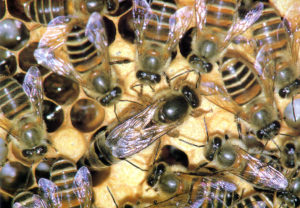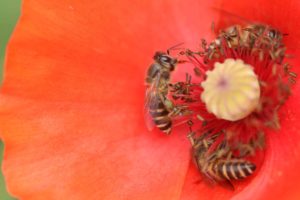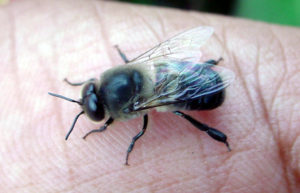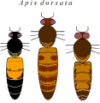Inner Anatomy of a Honey Bee
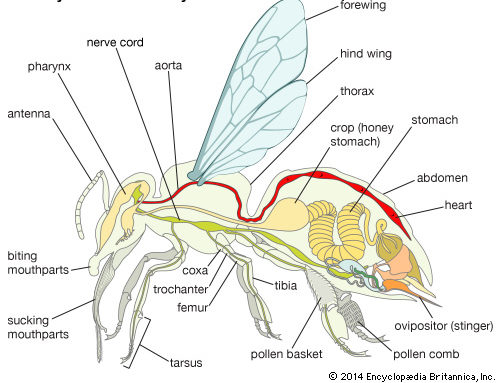
Drone, Worker, Queen
Queen – A colony will have only one queen. When a queen is chosen from the hive she will only be fed royal jelly. Once she has grown to full adulthood, she governs a hive by the release of her pheromones. For example, only a few days after emerging from her capped cell she will mate with multiple drones during a single flight and ultimately collect enough spermatozoa that will fertilize her eggs for the rest of her life. The pheromone used in this process is the same used by all species of the genera Apis. When a new queen emerges she takes over the original hive, while the old queen will abscond the hive with about half of the worker bees to establish a new nest. This process of absconding the nest is known as swarming – one queen (the original) will fly off with half the original colony and cluster onto a supporting branch (or something similar) and wait for “scout” bees to locate a proper nest site to construct a new hive. The new queen that remained at the original nest will start laying eggs a few days after mating and she can live for 4-5 years.
Worker – These bee are only female and come from fertilized eggs. They carry out many duties for the sake of the hive and it’s well being. At a young age the worker bee will maintain the nest (i.e. cleaning, tending the larvae) and secrete the wax to build the combs. Once their stingers have matured with venom then they can start to defend the nest. At the final stage of a worker bee’s life she will forage for nectar and pollen. They have a much shorter life span than the queen, living only 1-6 months.
Drone – These bees are only male and emerge from unfertilized eggs. Thus when they mate with the queen they pass on the genetic characteristics from their own mother-queen. Drone bees have a very short life-span of about 45-60 days and will die immediately after mating.
The Growth Cycle of Honey Bees
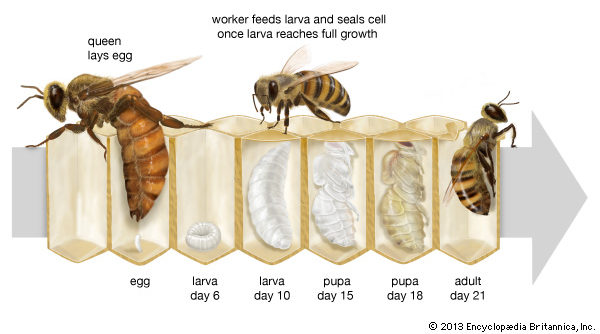
The worker bees (more specifically, “nurse” bees) will feed all bee larva with royal jelly three days after an egg has been laid within a cell. Eventually the substance that larvae are fed on will be switched to honey for worker and drone bees, while a queen bee larva will continue to be fed only royal jelly, a product made from the salivary glands of worker bees. After a few days each cell will be capped and a larva will then spin cocoon and proceed to the next developing stage of pupating. A queen will emerge 15 days after an egg is laid. For the worker and drone bees there is a longer growth cycle, with workers taking 21 days and drones taking even longer at 24 days. Often times multiples queens will emerge during a growth cycle and it is common for only one new queen to be permitted to live while the rest of the virgin queens are killed by the hive or the successful new queen.
Color Differentiation
“Body colour is an extremely distinctive characteristic among honeybee species and subspecies” (Chp.3, Asian Bees and Beekeeping). Among the European honeybees, all of the adults (workers, queens, and drones) within a subspecies will be the same color, which is either black or yellow banded. Whereas, the adults of Asian honeybees within the same species can be of different color variations and this is linked to sex or sexuality:
For the Asian species of Apis florea, the queens as well as workers will be yellow banded while the drones (male bee) are black. When a yellow queen mates with a black drone then they will produce yellow workers. Thus the females, being the queen and workers, are yellow, while the males, the drones specifically, are black. There is even a difference in yellow between the females of Apis florea. The queen will have more yellow coloring than the worker bees, thus even sexuality is color differentiated.
In Apis dorsata, both the queen and drones are brown while the workers are yellows. And this coloration remains steadfast so when a brown queen is mated with a brown drone then the result is of a yellow worker. Thus, in this case, color is a determinant or expression of sexuality, in that the adult honeybees that are sexual (drones and queens) will be brown while the infertile adult (workers) will remain yellow.
There is also color differentiation with Apis cerana, in that the workers are yellow while the queen and drones have a brownish-black coloration. Again, this is also indicates that color depends on sexuality given that queens and drones remain brownish-black while the workers are yellow.
In regards to Dammer bees, there is no color differentiation between the queen, worker, or drone bees. Instead they all share the same black coloration along with mild black stripes.
